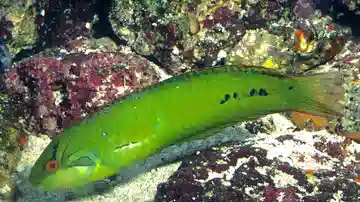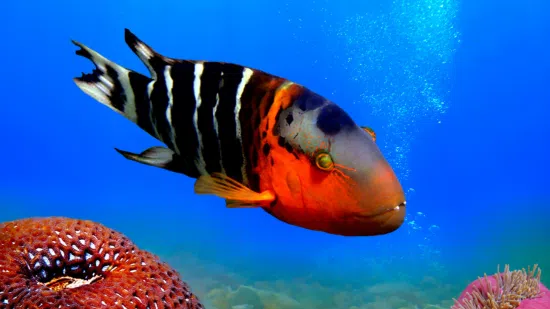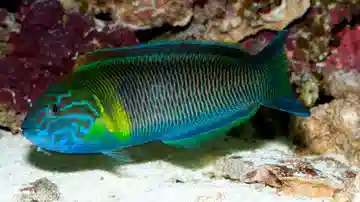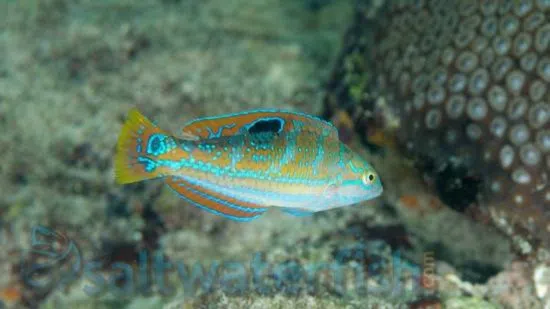Pudding Wife Wrasse
Halichoeres radiatus
(1 Reviews)

Pudding Wife Wrasse
Halichoeres radiatus
(1 Reviews)
{{ item.name }}
Size: {{ item.extra_field_3 }}
${{ getFormattedPrice(item.saleprice) }} ${{ getFormattedPrice(item.price) }}
To join the waiting list, click here
Free Shipping
With
$199.00
or more in Marine Life.
More details...
Pudding Wife Wrasse Care Facts
| Care Level: | Moderate |
|---|---|
| Temperament: | Peaceful |
| Diet: | Carnivore |
| Reef Safe: | No |
| Minimum Tank Size: | 100 Gallons |
| Max Size: | 20 inches |
Pudding Wife Wrasse (Halichoeres radiatus): A Comprehensive Guide for Saltwater Aquarists Who Like Fish with Goofy Names
The Pudding Wife Wrasse, scientifically known as Halichoeres radiatus, is a fascinating marine fish species that can be a captivating addition to your saltwater aquarium. In this straightforward and informative guide, we will explore crucial aspects of this fish, including its natural habitat, reef compatibility, size, lifespan, dietary requirements in captivity, aquaculture status, compatibility with other marine species, sexual dimorphism, juvenile to adult coloration changes, temperament, detailed tank requirements, precise water conditions, and its intriguing name origin. Additionally, we will list alternative common names for the Pudding Wife Wrasse and explain why choosing Saltwaterfish.com for your purchase is a reliable decision.
Habitat and Natural Range of the Pudding Wife Wrasse
The Pudding Wife Wrasse, Halichoeres radiatus, inhabits the warm tropical waters of the Western Atlantic Ocean. These colorful fish are typically found near coral reefs, rocky outcrops, and shallow coastal areas. Understanding their natural habitat is vital for creating a suitable environment within your aquarium.
Reef Compatibility of the Pudding Wife Wrasse
The Pudding Wife Wrasse is not reef-safe.
Size and Lifespan of the Pudding Wife Wrasse
Pudding Wife Wrasses are collected relatively small in size, but they grow with adults, reaching an average length of 20 inches. In captivity, with proper care, they can live for up to 5 to 7 years or even longer, making them a rewarding long-term addition to your aquarium.
The Pudding Wife Wrasse's Diet in Captivity
Feeding the Pudding Wife Wrasse in captivity is relatively straightforward, as they are omnivorous and prefer a varied diet. Their diet should primarily consist of:
- Protein-based foods: Offer high-quality marine-based pellets, flakes, and frozen foods like brine shrimp, mysis shrimp, and krill.
- Plant matter: Incorporate vegetable-based foods like spirulina flakes or sheets to provide essential fiber and nutrients.
- Live or frozen prey: Occasional offerings of live or frozen foods can stimulate their natural hunting instincts.
A varied diet supports their health and enhances their vibrant coloration, making them a captivating spectacle in your aquarium.
Aquaculture and Availability of the Pudding Wife Wrasse
As of now, Pudding Wife Wrasses are not available through aquaculture. However, they are frequently accessible in the aquarium trade, making them a viable choice for hobbyists. Choose a responsible supplier.
Compatibility of the Pudding Wife Wrasse with Other Fish and Invertebrates
Pudding Wife Wrasses are generally peaceful and can coexist with various marine species. When selecting tankmates, consider their size, compatibility, and behavior. Here are five compatible tankmates for your Pudding Wife Wrasse:
- Clownfish (Amphiprion spp.): These iconic reef fish make excellent tankmates due to their peaceful nature.
- Chalk Bass (Serranus tortugarum): These small, colorful basslets are suitable companions for Pudding Wife Wrasses.
- Firefish Goby (Nemateleotris spp.): Their size and temperament make them compatible with your Wrasse.
- Cleaner Shrimp (Lysmata spp.): These shrimp species can safely cohabitate in a reef environment.
Sexual Dimorphism
Pudding Wife Wrasses exhibit sexual dimorphism, meaning there are distinct differences in appearance between males and females. Males typically display more vibrant coloration and may have slightly different fin shapes than females.
Juvenile to Adult Coloration Changes
Juvenile Pudding Wife Wrasses are known for their vibrant colors and striking patterns. As they mature into adults, their colors may become slightly subdued, but they retain their distinctive appearance, including the intriguing name-sake patterning.
Temperament of the Pudding Wife Wrasse
These wrasses are generally peaceful and non-aggressive. However, providing ample hiding places and territories within your aquarium is essential to prevent territorial disputes.
The Pudding Wife Wrasse's Tank Requirements
To ensure the well-being of your Pudding Wife Wrasse, consider the following tank requirements:
- Minimum Aquarium Size: A tank with a minimum capacity of 100 gallons (189 liters) is recommended to accommodate their swimming habits and provide ample hiding spots.
- Aquascaping: Create an environment that mimics their natural reef habitat, incorporating live rock formations and crevices for hiding and exploration.
Detailed Water Conditions for the Pudding Wife Wrasse
Maintaining precise water conditions is vital for the health of your Pudding Wife Wrasse:
- pH: Keep the pH level within the range of 8.1 to 8.4 to ensure a stable and suitable alkaline environment.
- Salinity: Maintain the salinity level at 1.022 to 1.025 to support proper osmoregulation.
- Water Temperature: Keep the water temperature consistently between 76°F to 82°F (24°C to 28°C) to ensure their comfort and well-being.
- Water Flow: Provide moderate water flow to replicate their natural reef habitat without causing excessive turbulence.
Other Common Names for the Pudding Wife Wrasse
The Pudding Wife Wrasse goes by several other common names, including the Radiant Wrasse and the Radiated Wrasse.
Origin of the Pudding Wife Wrasse's Name
The origin of the name "Pudding Wife Wrasse" is not definitively known but is thought to be derived from the distinctive coloration and patterns on this fish. The vibrant and radiating colors on its body might have reminded someone of a colorful, decorative pudding or the appearance of a dressed-up wife, hence the name.
Why People Should Buy the Pudding Wife Wrasse from Saltwaterfish.com
- Quality Assurance: Saltwaterfish.com is dedicated to delivering healthy and vibrant Pudding Wife Wrasses. Each fish undergoes careful selection to guarantee top-quality specimens.
- Expert Support: Our team of marine experts is readily available to offer guidance and assistance, ensuring your Pudding Wife Wrasse thrives in your aquarium.
- Convenience: We provide a seamless online selection process and reliable home delivery, making it convenient for you to acquire your Pudding Wife Wrasse.
- Sustainability: By choosing Saltwaterfish.com, you support responsible collection practices and marine conservation, contributing to the well-being of marine ecosystems.
In conclusion, the Pudding Wife Wrasse (Halichoeres radiatus) is a captivating and reef-safe addition to your saltwater aquarium. Saltwaterfish.com offers a reliable source for obtaining healthy and vibrant Pudding Wife Wrasses, backed by a commitment to ethical collection practices and marine conservation. Add a touch of radiant elegance to your aquarium with the Pudding Wife Wrasse.
I bought this Pudding Wife Wrasse here and to show you how hardy this guy is, he was the most active of 5 fish I had delivered when outside temp in MN was 21 degree out and bag water was at 68 degrees. All survived after 2 1/2 hr slow drip acclimation. He is a colorful little guy to watch darting around the tank. He is constantly on the move searching for food or detritus on the bottom as well as on reef rock. Likes to dart in and out of rock. He is getting much better at snagging Mysis shrimp I drop in before the other 6 fish hog it all, especially my Hamlet Indigo who gobbles everything that moves. A joy to watch.
Reviewed by: Philip Brock on Dec. 31, 2021



















